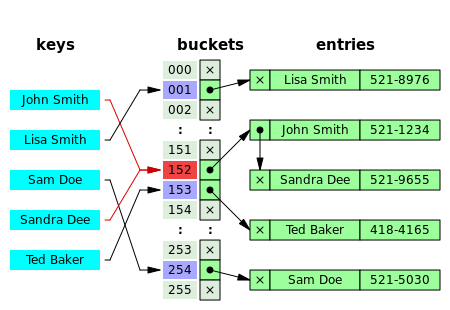Difference between revisions of "Chained Dictionary Assignment"
| Line 2: | Line 2: | ||
In this and the follow up [[Sorted_Dictionary_Assignment|Sorted Dictionary]] studio, you will build three implementations of a dictionary. Each will be a persistent, mutable data structure, so you can expect to use the [http://sml-family.org/Basis/general.html#SIG:GENERAL.!:VAL ref] feature of SML, either directly or via the mutable [http://sml-family.org/Basis/array.html Array structure]. | In this and the follow up [[Sorted_Dictionary_Assignment|Sorted Dictionary]] studio, you will build three implementations of a dictionary. Each will be a persistent, mutable data structure, so you can expect to use the [http://sml-family.org/Basis/general.html#SIG:GENERAL.!:VAL ref] feature of SML, either directly or via the mutable [http://sml-family.org/Basis/array.html Array structure]. | ||
| + | |||
| + | =Background= | ||
| + | [https://www.cs.cornell.edu/courses/cs312/2008sp/recitations/rec15.html Refs and Arrays] | ||
| + | |||
| + | =Permission= | ||
| + | You may invoke remove from put and get from remove if it will make your implementation cleaner. | ||
| + | |||
| + | =Dictionary= | ||
| + | ==Signature== | ||
<nowiki>signature DICTIONARY = sig | <nowiki>signature DICTIONARY = sig | ||
type (''k,'v) dictionary | type (''k,'v) dictionary | ||
| Line 11: | Line 20: | ||
val values : (''k,'v) dictionary -> 'v list | val values : (''k,'v) dictionary -> 'v list | ||
end</nowiki> | end</nowiki> | ||
| − | + | ==Spec== | |
| − | = | + | ===get=== |
| − | |||
| − | |||
| − | = | ||
| − | |||
| − | |||
| − | |||
| − | ==get== | ||
Behaves much like [https://docs.oracle.com/javase/8/docs/api/java/util/Map.html#get-java.lang.Object- java.util.Map<K,V>'s get(key) method] except instead of returning null or the associated value, it returns an option. | Behaves much like [https://docs.oracle.com/javase/8/docs/api/java/util/Map.html#get-java.lang.Object- java.util.Map<K,V>'s get(key) method] except instead of returning null or the associated value, it returns an option. | ||
| − | ==put== | + | ===put=== |
Behaves much like [https://docs.oracle.com/javase/8/docs/api/java/util/Map.html#put-K-V- java.util.Map<K,V>'s put(key,value) method] except instead of returning null or the previously associated value, it returns an option. | Behaves much like [https://docs.oracle.com/javase/8/docs/api/java/util/Map.html#put-K-V- java.util.Map<K,V>'s put(key,value) method] except instead of returning null or the previously associated value, it returns an option. | ||
| − | ==remove== | + | ===remove=== |
Behaves much like [https://docs.oracle.com/javase/8/docs/api/java/util/Map.html#remove-java.lang.Object- java.util.Map<K,V>'s remove(key) method] except instead of returning null or the previously associated value, it returns an option. | Behaves much like [https://docs.oracle.com/javase/8/docs/api/java/util/Map.html#remove-java.lang.Object- java.util.Map<K,V>'s remove(key) method] except instead of returning null or the previously associated value, it returns an option. | ||
| − | ==entries== | + | ===entries=== |
Behaves much like [https://docs.oracle.com/javase/8/docs/api/java/util/Map.html#entrySet-- java.util.Map<K,V>'s entrySet() method]. | Behaves much like [https://docs.oracle.com/javase/8/docs/api/java/util/Map.html#entrySet-- java.util.Map<K,V>'s entrySet() method]. | ||
| − | ==keys== | + | ===keys=== |
Behaves much like [https://docs.oracle.com/javase/8/docs/api/java/util/Map.html#keySet-- java.util.Map<K,V>'s keySet() method]. | Behaves much like [https://docs.oracle.com/javase/8/docs/api/java/util/Map.html#keySet-- java.util.Map<K,V>'s keySet() method]. | ||
| − | ==values== | + | ===values=== |
Behaves much like [https://docs.oracle.com/javase/8/docs/api/java/util/Map.html#values-- java.util.Map<K,V>'s values() method]. | Behaves much like [https://docs.oracle.com/javase/8/docs/api/java/util/Map.html#values-- java.util.Map<K,V>'s values() method]. | ||
Revision as of 19:47, 2 March 2020
Contents
Motivation
In this and the follow up Sorted Dictionary studio, you will build three implementations of a dictionary. Each will be a persistent, mutable data structure, so you can expect to use the ref feature of SML, either directly or via the mutable Array structure.
Background
Permission
You may invoke remove from put and get from remove if it will make your implementation cleaner.
Dictionary
Signature
signature DICTIONARY = sig
type (''k,'v) dictionary
val get : ((''k,'v) dictionary *''k) -> 'v option
val put : ((''k,'v) dictionary *''k *'v) -> 'v option
val remove : ((''k,'v) dictionary *''k) -> 'v option
val entries : (''k,'v) dictionary -> (''k*'v) list
val keys : (''k,'v) dictionary -> ''k list
val values : (''k,'v) dictionary -> 'v list
end
Spec
get
Behaves much like java.util.Map<K,V>'s get(key) method except instead of returning null or the associated value, it returns an option.
put
Behaves much like java.util.Map<K,V>'s put(key,value) method except instead of returning null or the previously associated value, it returns an option.
remove
Behaves much like java.util.Map<K,V>'s remove(key) method except instead of returning null or the previously associated value, it returns an option.
entries
Behaves much like java.util.Map<K,V>'s entrySet() method.
keys
Behaves much like java.util.Map<K,V>'s keySet() method.
values
Behaves much like java.util.Map<K,V>'s values() method.
DictionaryUtils
All three implementations of dictionary can reuse the same functions which given a list of entries produce the keys and values.
One of List's higher order functions can be useful here. Which one is it?
fun entries_to_keys(entries : (''k*'v) list) : ''k list =
raise NotYetImplemented
fun entries_to_values(entries : (''k*'v) list) : 'v list =
raise NotYetImplemented
ListOfEntries (Optional But Encouraged)
While it is not required, both the SingleList and Hashtable implementations will have a lot of overlap. Building the common functionality will allow you to reuse this code. Further, some students have reported the separation helping with wrangling the references in the dictionaries.
exception KeyNotFound
fun internal_remove(entries : (''k*'v) list, key : ''k) : 'v option * (''k * 'v) list =
raise NotYetImplemented
fun list_get(entries : (''k*'v) list, key : ''k) : 'v option =
raise NotYetImplemented
fun list_put(entries : (''k*'v) list, key : ''k, value : 'v) : 'v option * (''k * 'v) list=
raise NotYetImplemented
fun list_remove(entries : (''k*'v) list, key : ''k) : 'v option * (''k * 'v) list =
raise NotYetImplemented
SingleList Implementation
signature SINGLE_LIST_DICTIONARY = sig include DICTIONARY
val create_simple : unit -> (''k,'v) dictionary
end
Hashtable Implementation
signature HASHED_DICTIONARY = sig include DICTIONARY
type ''k hash_function = ''k -> int
val create_hashed : (int * ''k hash_function) -> (''k,'v) dictionary
end
